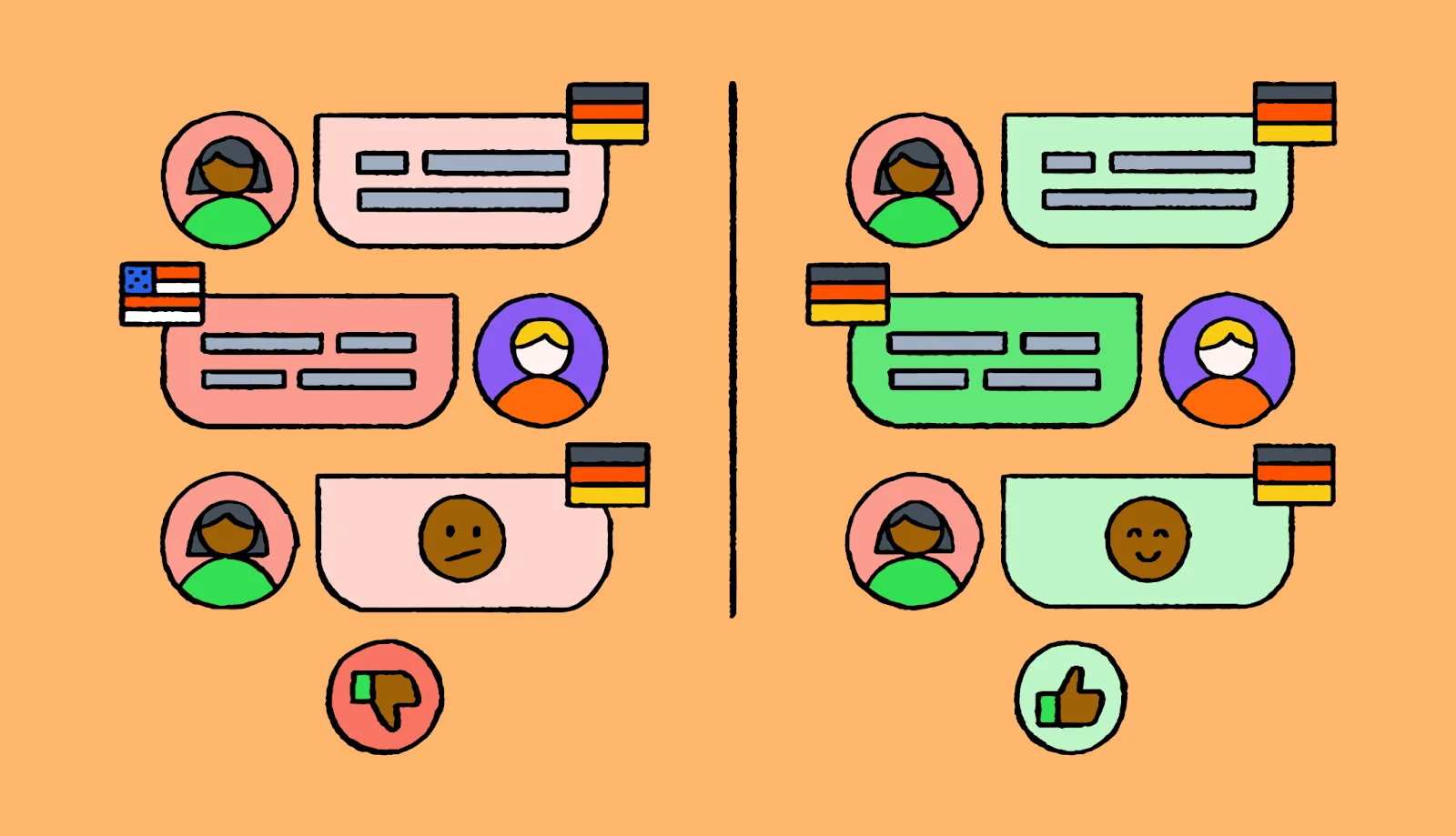Shoppers from around the world are visiting your ecommerce store.
But when a customer in France has a question about sizing, they’re met with a reply in English they can barely understand. Their excitement quickly turns to frustration and they abandon their cart.
This is the cost of not offering multilingual customer support.
As a business owner, nothing stings more than watching a potential sale slip away simply because of a language barrier.
Let’s look at exactly what multilingual customer support means and 5 reasons why it’s paramount for your ecommerce business.
What is multilingual customer support?
Multilingual customer support involves providing customer service to every customer group, at every touchpoint, in their native language. It’s important to any business entering into a market where the local language is different from their own.
It’s also becoming increasingly common in multicultural societies, such as the United States, where more than 350 different languages are spoken.

Providing multilingual support increases the accessibility and inclusivity of your business and improves customer satisfaction before or after they complete their purchase.
However, this does not mean using Google translate for your website or support materials. This quick-fix band aid neglects the cultural context and nuances embedded in different languages.
Instead, multilingual customer support involves training fluent-speaking reps to deliver culturally accurate and relatable multilingual support across every channel: phone, email, chatbot, etc.
5 reasons why multilingual customer support is important
According to a recent survey, being able to choose a language is a basic customer expectation, not a bonus. The global market doesn’t speak just one language, so your business shouldn’t either.
Here are 5 reasons why your business should offer multilingual customer support:
1. An increase in sales
It’s no secret that people are more likely to purchase from a brand if their website and product information is available in their native language.
13% of customers would switch to an ecommerce store that’s translated into their native language.
By offering multilingual customer support, you’re removing those language barriers and making it easier for customers around the world to buy from you. So, if you want to see those sales grow, get talking and translating. Pronto.
2. Access to wider markets
You might think that English might be widely spoken in all corners of the world. The truth is only 20% of the world’s population speaks English. This means that the majority, an untapped market of potential customers, don’t.
To tap into that international audience, you have to speak their language.
3. More happy and satisfied customers
We mostly reach out to customer service when we’ve encountered a problem.
Either we have questions about the product or it’s not working the way we want it to. In both cases, it’s very easy to become upset when things don’t go our way — this is where miscommunication, angry emails, and yelling via phone usually happens.
To improve the situation, it’s better to communicate with the customers in their own language because:
- They can express themselves more easily
- You won’t lose important bits of information in translation
- You’ll remove the customer’s anxiety of speaking another language
4. Deeper customer loyalty and trust
Imagine buying new headphones from a company overseas, only to find they don’t work. Wouldn’t it be easier to resolve the issue in your own language? Speaking to someone who understands you builds trust, which is essential at all stages of the purchasing cycle, including customer support.
Offering multilingual customer support increases customer retention and brand loyalty because the customers know that there will be someone that understands them and their needs. In the long run, fostering a loyal customer base is far more valuable than focusing on one-time sales.
5. Competitive advantage
Did you know that 40% of customers outright refuse to buy anything from websites that are not in their native language? Don’t lose out because you don’t speak their language.
Think about it. Suppose you bought similar products from two different companies. One company provides a multilingual customer service rep who speaks your language and can easily answer your questions. The other doesn’t.
Who would you choose? You probably already know the answer.
How to optimize your customer support channels
Consider optimizing these channels to create a personalized customer experience for your global customers:
Website
One of the first places a customer looks for support is your website. It’s your digital storefront, and first impressions do matter. If customers can’t easily navigate or understand your website in their language, they’re likely to look elsewhere.
Aside from translating your website, make sure everything, from product descriptions and FAQs to error messages and checkout pages, resonates culturally with your target audience. While initially it may seem like a big project, you’ll increase conversion rates, improve SEO in target markets, and establish a stronger brand image in those specific regions.
Or, implement geolocation detection (based on IP address) or browser language settings so that the website is automatically displayed in the user’s preferred language. This little feature greatly improves user experience, especially for first-time visitors.
Another effective way is to offer a language switcher on your website. Make sure it’s accessible even to non-native speakers with clear flags or language names. It requires minimal effort, but caters to a much wider audience.
Email is a staple for customer support, especially for businesses with international customers. It provides a convenient and accessible channel for your customers to reach out to you in their time zone.
Multilingual email templates are a cost-effective way to ensure your customers receive support in their preferred language. Translating your standard replies in their language creates a more personal experience that builds trust and rapport.
But, emails may not be the fastest way to communicate and resolve issues. While 69% of customers want brands to respond within 24 hours, it may not always be possible.
However, it does give your business time to provide thoughtful responses. Your multilingual support team can take the time to research and provide detailed solutions. And, you can automate certain responses so that customers can at least receive acknowledgement.
Not to mention, email threads provide a record of each conversation. This makes it easier to keep track of issues, analyze trends, and improve your support process.
Live chat and chatbots
Live chat and chatbots offer the immediate, real-time support that customers crave. You’re essentially providing access to 24/7 service at a few quick clicks.

Chatbots, in particular, are great for addressing simple inquiries and basic troubleshooting. For example, tracking a delivery can be easily automated and handled. It’s a cost-effective way for businesses with limited resources, as chatbots can handle large volumes of questions, freeing up your employees for other work.
However, chatbots lack the nuance and empathy of human interaction, which can lead to impersonal or even frustrating experiences for customers. Customers can get stuck in a loop of automated responses, nowhere near their desired answer.
Live chat, on the other hand, offers that human touch. A trained live customer support agent can provide personalized help, resolve complex problems, and build rapport with customers. But it’s more costly to hire and train different reps for each language.
Phone support
Phone support offers a level of human connection and personalized interaction that other channels just can’t match. Customers can speak directly to a live agent, explain their concerns in detail, and receive answers in real time. Through phone conversations, you can also gather insights into customer needs and pain points.
However, it does come with its challenges. Hiring and training multilingual agents to provide 24/7 support is expensive. Additionally, customers may face long wait times during peak hours, leading to frustration. Let’s be honest — we’ve probably all been put on hold for an excruciatingly long time at least once.
Despite these challenges, investing in skilled multilingual agents and efficient call routing systems can create an effective support experience that sets your brand apart.
Social media
Social media has become a go-to channel for customers who need support, thanks to its convenience and public nature. They can easily tag your brand in a post or comment, reaching you even if they haven’t directly contacted your customer service team.
This allows you to proactively address concerns around the globe, showcase your responsiveness, and publicly build a reputation for quality customer support. Yet, negative feedback or unresolved complaints are shared publicly and can quickly escalate and damage your brand image.
Moreover, managing multiple language accounts across various platforms can be overwhelming and resource-draining. It requires your team to be constantly monitoring and responding to messages in different languages.
Help centers and knowledge bases
Empower your customers to find their own solutions without having to wait for a response from your support team.
By providing comprehensive FAQs, troubleshooting guides, video tutorials, and other helpful resources in multiple languages, you’re giving them the tools to solve problems whenever they need to. This reduces the burden on your staff, minimizes support tickets, and allows your team to focus on other issues.
Of course, there are some things to keep in mind. Organizing your knowledge base effectively is key, so customers can easily find what they’re looking for. And while self-service is great for many issues, some problems will still require personalized support.
How to make multilingual customer support cost-effective
Multilingual customer support is important for any business that wants to go global, but how do you create a cost-effective multilingual customer support strategy?
Follow these steps to get started:
Understand the scope of languages needed
Analyze which languages come into your contact center or inbox most frequently. Are there languages that the existing customer service team can cover, and to what capacity, compared to English?
And what are the most common languages not supported by your agents, but demanded by customers? The best way to get to the bottom of this is to take an in-depth look into your target market and your current customer base.
Choose the right support channels
Ask yourself: what kind of support do your customers really need? Can you afford to provide it during peak times? Do you need multiple channels to meet diverse preferences?
The key is to understand your customer’s preferences. Interestingly, while 41% of customers prefer live chat, 42% of businesses think they prefer phone support. The goal is to find the right mix of support channels to maximize customer satisfaction without overstretching your team.

Consider factors like cost, resource availability, customer preferences, and the complexity of common issues. For example, if your products require a lot of technical explanation, live chat or phone support might be more suitable than email.
Additionally, think bigger and further. Can your strategy support growth targets for the next quarter? Next year? Choose solutions that can easily scale as your business grows.
Use translation tools
Eighty percent of operations managers say AI and automation are significantly reducing tedious tasks for customer service agents. It’s time to leave it to the machines.
- Translation plugins that provide real-time support, automatically translate conversations on your website, mobile app, or in your product.
- AI-powered chatbots can also handle a wide range of customer inquiries, from answering FAQs to resolving simple issues like password resets or order tracking. You can also automate email replies for support tickets in the customer’s preferred language.
By automating repetitive tasks and streamlining workflows, you can only reduce the manual support burden on your team but also provide faster, and more consistent support experiences for your global customers.

Thrive in a global market with Lokalise
Speaking your customer’s language might just be the deciding factor that makes people choose your brand instead of your competitors.
So, if you want to stand out with a multilingual service, give Lokalise a try.
- For real-time translation of incoming and outgoing customer support messages, try Lokalise Messages for free
Need help translating your help desk articles? Try Lokalise TMS for free (translation management system)





